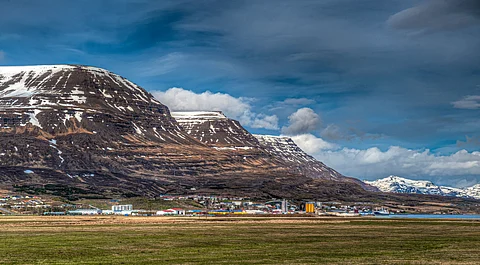

The coastal town of Fjarðabyggð in the East Fjords, Iceland, where part of the money from the Aquaculture Fund will go towards the renovation of the Icelandic World War II Museum.
Photo: Joan Vadell / Adobe Stock.
Iceland's Ministry of Industry and Trade - the competencies for aquaculture and fisheries are in this ministry after the change of government in December - announced that the Aquaculture Fund Board has already decided on the allocations for 2025.
As was the case in 2024, this year the municipalities in the West Fjords (Vestfjörður) have taken the largest share of the fund, 61% - last year it was 56% - which equals a total of ISK 285.7 million (EUR 1.9 million / USD 2.2 million). The remaining 39%, ISK 179.3 million (EUR 1.2 million / USD 1.4 million), went to localities in the East Fjords (Austurland), which, percentage-wise, this time received less than last year, when they took 44%.
In total, more than ISK 465 million (EUR 3.2 million - USD 3.6 million) has been allocated by the Aquaculture Fund Board to fifteen projects in seven municipalities. Of these, the bulk, more than ISK 200 million (EUR 1.3 million / 1.5 million) were allocated to the "other" category, ranging from town planning projects to investments in water supply or sewage systems, from improvements to sports facilities or fire stations to, as in the case of Fjarðabyggð in the East Fjords, the renovation of the Icelandic World War II Museum.
The next largest category was "school projects". More than ISK 125 million (EUR 864,402 / USD 983,929) will go to Phase 1 of the expansion of the Bjarkatún preschool in Djúpivogur, in the municipality of Múlaþing in the East Fjords, and the construction of the school in Bíldudalur, in the municipality of Vesturbyggð, in the West Fjords, where Iceland's leading salmon farming company, Arnarlax, is based, and which, a couple of years ago, secured there the construction of homes for its workers in the locality.
In its release on the allocations, the Ministry of Industry and Trade of Iceland recalled that the Aquaculture Fund Board must professionally evaluate applications and projects and prioritize them according to the purpose of the fund and the Board's own current priorities.
By the application deadline on March 10, the Aquaculture Fund Board had received a total of thirty applications from seven municipalities, amounting to more than ISK 1.7 billion (EUR 11.7 million / USD 13.3 million), almost four times the amount available for allocation.
In this 2025 call, the total amount of approved applications was ISK 1,123,114,018 (EUR 7,766,575 / USD 8,840,085). However, as the available budget of the fund was lower, the Board decided to set a funding ceiling of ISK 60 million (EUR 414,929 / USD 472,187) per project.
Afterwards, the approved applications were reduced proportionally according to pre-established evaluation methods and then adjusted, also proportionally, based on the Fund's available budget for 2025, which was specifically ISK 465.1 million (EUR 3.21 million / USD 3.65 million).
"The Board considers that all funded projects align well with the fund's priorities and are suitable for strengthening infrastructure and economic activity in areas where sea-based aquaculture is practiced," the Ministry of Industry's release read.
Since the establishment of the Fund in 2021, a total of ISK 1,440 million (EUR 9.9 million / USD 11.3 million) has been allocated to various projects in the respective municipalities to help meet the growing demands of residents and economic activities in line with increased activity in marine aquaculture.
In 2024, export revenue from fish farming marked a record year in Iceland, increasing by more than 16% over 2023, with salmon consolidating its position as the second-highest export value of all fish species. Sea-based salmon farming has become one of Iceland's most important export industries and a pillar of economic activity in rural areas.
Thus, although according to a Gallup poll conducted in July 2024, more than 65% of Icelanders oppose open-net salmon aquaculture, what is now being debated in the Icelandic Parliament is not whether or not the country should have aquaculture, but whether or not foreign ownership of sea-based salmon farming should be limited.
